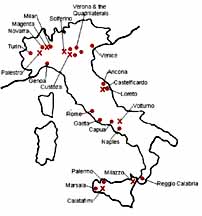The author, who may be reached at Robert.Avery@express.co.uk, has kindly shared his history of the Risorgimento on his website with readers of the Victorian Web. The copyright for text and images of course remains with him.
 art of Bismark's preparation for the Austro-Prussian War was a Prussian-Italian alliance aimed firmly at Austria. The Third War of Italian Unification began when Austria refused to allow Italy to buy Veneto from them, and, concerned about the Italian alliance with Prussia, accused the Italians of strengthening their army in Lombardy. Both sides began to mobilise and, when the Prussians finally declared war on the Austrians on 16th June 1866, the Italians and followed suit.
art of Bismark's preparation for the Austro-Prussian War was a Prussian-Italian alliance aimed firmly at Austria. The Third War of Italian Unification began when Austria refused to allow Italy to buy Veneto from them, and, concerned about the Italian alliance with Prussia, accused the Italians of strengthening their army in Lombardy. Both sides began to mobilise and, when the Prussians finally declared war on the Austrians on 16th June 1866, the Italians and followed suit.
Although the Italians outnumbered the Austrians about 250,000 to 190,000, this advantage was largely negated by the fact that the Austrians could fight defensively from behind the Quadrilateral forts and had a shorter supply chain through the valley of the Adige. This advantage was also greatly increased by the fact that the Italian army had no clear chain of unified command: Garibaldi unilaterally commanded 20,000 volunteers in the Alps to the north; and the main Italian army was split into two forces commanded by La Marmora and Cialdini, the latter being wildly jealous of the other and refusing to take direct orders. Add the intervention of Vittorio Emanuele, armchair strategist extraordinaire, and it is hardly surprising that no sensible line of attack could be decided upon.
Map of Italy with sites relevant to the Wars of Unification. © Robert Avery.
Clicking on the image at right will produce a larger map in a second window.
The first fighting was at Custoza: where La Marmora allowed himself to get sucked into an unexpected battle fighting an Austrian force under Archduke Albrecht fighting from prepared positions on higher ground and with internal lines. Casualties were about even in this inconclusive fight; but La Marmora, lacking intelligence (of the military, not cerebral, sort), reacted as if the Italians had suffered a great defeat. This feeling spread throughout the army, and succeeded in demoralising the entire country!
The Austrians, however, did not follow up and, after their northern army was soundly defeated by the Prussians at Sadowa, recalled Albrecht and the bulk of his force to defend Austria itself. The Italians, with the main force now wholly under Cialdini, started forward again, bypassed the Quadrilaterals, and began to take Venetian cities behind them. Garaibaldi also managed to clear the Austrians from some of the Alpine valleys, although he was now leading his men from a carriage after taking a wound to his leg.
Unfortunately for the Italians, this was the high point of their campaign. They lost a naval battle at Lissa despite outnumbering the Austrians twelve ironclads to seven (the Austrians, under von Tegethoff, using the ram rather than their inferior guns) and, when the Prussians broke the terms of their Prussian-Italian alliance and signed a peace treaty with the Austrians, found themselves facing the entire Austrian army of some 300,000 troops!
An armistice was signed on 12th August which led to a treaty that gave Italy control of Veneto and recognition by Austria as a nation. The Third War of Italian Unification had led to political, if not military, gains.
Rome
Garibaldi was still, however, not content: the unification of Italy required Rome and the reduced Papal States. The Italian/Sardinian government, recognising that they did not have the backing of the European powers for an invasion, was content to try to negotiate themselves into Rome but, after a year of furious politiking, Garibaldi lost patience and led a volunteer army into the region.
Although the Garibaldini succeeded in capturing the Papal city of Moterotondo, he and his ten thousand volunteers then found themselves facing the Papal army of 15,000 and a newly-arrived French force landing at Civitavecchia, armed with new-fangled breech-loading rifles. Even worse, the Italian/Sardinian government had also announced that it would not tolerate this latest 'rebellion', and was planning to send Italian troops to arrest Garibaldi and the volunteers!
With men leaving his army in droves, Garibaldi fought a battle at Mentana: where his 4,000 remaining troops faced a combined Papal and French army of 9,000. Although Garibaldi tried his usually tactics of inspirational charges, the odds were too great, and the volunteers already too dispirited. After suffering a conclusive defeat, Garaibaldi and the survivors were forced to retreat back across the border: Garibaldi being arrested as he attempted to return home to Caprera.
Postscript
Rome was eventually joined to Italy towards the end of the Franco-Prussian war. After the French defeat at Sedan, their troops in Rome were withdrawn to help defend Paris. The Italians 'seized the day', and sent an overwhelming force (30,000 plus artillery) into the Papal States and, after a short fight with the Papal army, Rome was formerly annexed to the Kingdom of Italy. The Risorgimento was over.
Related Materials
- The Risorgimento or Unification of Italy (1815-1871): An Introduction
- The First Italian War of Independence (1848-49) — a Military History
- The Franco-Austrian War or Second War of Italian Unification (1859)
- Views of a Memorial to Garibaldi, Bologna
Last modified 18 November 2004
